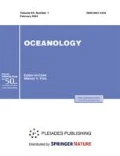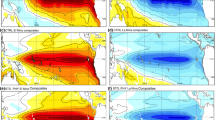Abstract
In this paper, we present the results of modeling of El Niño events using a simple model of a classical oscillator with decay under external forcing. The sea surface temperature in the East Pacific and the mean thermocline depth in the Equatorial Pacific correspond to the roles of the momentum and position, respectively. The external forcing of the system is determined by two factors: the short-period meridional mass fluctuations in the Pacific sector of the Southern Ocean due to the joint effect of the atmospheric variability over the Antarctic Circumpolar Current, bottom topography, and coastlines; and the variability of western winds in the tropics. Under such conditions, oscillations of El Niño type arise in the model as a result of propagation of signals generated in the Southern Ocean (due to the fluctuations of meridional transport fluxes and the variability of western winds in the tropics). These signals propagate over the Equatorial Pacific as fast wave processes. It is shown that external forcing is the main factor in establishing the oscillation pattern of the model characteristics variability.
Similar content being viewed by others
References
V. N. Stepanov, “Variability of Meridional Flux Processes in the Southern Ocean and their Possible Relation to Elño,” Okeanologiya 49(1), 5–19 (2009) [Oceanology 49 (1), (2009)].
F. Alvarez-Garcia, W. C. Narvaez, and M. J. Ortiz Bevia, “An Assessment of Differences in ENSO Mechanisms in a Coupled GCM Simulation,” J. Climate 19(1), 69–87 (2006).
A. T. Blaker, B. Sinha, V. O. Ivchenko,et al., “Identifying the Roles of the Ocean and Atmosphere in Creating a Rapid Equatorial Response to a Southern Ocean Anomaly,” Geophys. Res. Lett. 33, L06720 (2006).
C. S. Bretherton, M. Widmann, V. P. Dymnikov, et al., “The Effective Number of Spatial Degrees of Freedom of a Time-Varying Field,” J. Climate 12(7), 1990–2009 (1999).
G. Burgers, F.-F. Jin, and G. J. van Oldenborgh, “The Simplest ENSO Recharge Oscillator,” Geophys. Res. Lett. 32, L13706 (2005).
V. O. Ivchenko, V. B. Zalesny, and M. R. Drinkwater, “Can the Equatorial Ocean Quickly Respond to Antarctica Sea Ice/Salinity Anomalies?,” Geophys. Res. Lett. 31, L15310 (2004).
F.-F. Jin, “Tropical Ocean-Atmosphere Interaction, the Pacific Cold Tongue, and the El Niño/Southern Oscillation,” Science 274(5284), 76–78 (1996).
W. S. Kessler, “Is ENSO a Cycle or Series of Events?” Geophys. Res. Lett. 29(23), 2135 (2002).
M. Lengaigne, E. Guilyardi, J.-P. Boulanger, et al., “Triggering of El Nino by Westerly Wind Events in a Coupled General Circulation Model,” Clim. Dyn. 23(6), 601–620 (2004).
G. Richardson, M. R. Wadley, K. Heywood, et al., “Short-Term Climate Response to a Freshwater Pulse in the Southern Ocean,” Geophys. Res. Lett. 32, L03702 (2005).
C. F. Ropelewski and P. D. Jones, “An Extension of the Tahiti-Darwin Southern Oscillation Index,” Mon. Weather Rev. 115(9), 2161–2165 (1987).
V. N. Stepanov and C. W. Hughes, “The Parameterization of Ocean Self-Attraction and Loading in Numerical Models of the Ocean Circulation,” J. Geophys. Res. 109, C0037 (2004).
V. N. Stepanov and C. W. Hughes, “Propagation of Signals in Basin-Scale Bottom Pressure from a Barotropic Model,” J. Geophys. Res. 111, C12002 (2006).
M. Suarez and P. S. Schopf, “A Delayed Action Oscillator for ENSO,” J. Atmos. Sci. 45(21), 3283–3287 (1988).
K. E. Trenberth, “Signal Versus Noise in the Southern Oscillation,” Mon. Weather Rev. 112(2), 326–332 (1984).
Author information
Authors and Affiliations
Corresponding author
Additional information
Original Russian Text © V.N. Stepanov, 2009, published in Okeanologiya, 2009, Vol. 49, No. 3, pp. 337–347.
Rights and permissions
About this article
Cite this article
Stepanov, V.N. Modeling of El Niño events using a simple model. Oceanology 49, 310–319 (2009). https://doi.org/10.1134/S0001437009030023
Received:
Accepted:
Published:
Issue Date:
DOI: https://doi.org/10.1134/S0001437009030023




